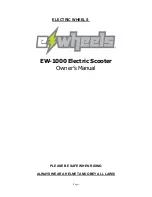
Service
4.2.3 Error codes and diagnostic codes
Flash code
Fault
Consequence for the
scooter
Comments
1
Batteries must be
charged
Continues to drive
•
The batteries are discharged. Charge the batteries
as soon as possible.
2
Battery voltage too low
Stops driving
•
The batteries are depleted. Charge batteries.
•
If you switch the scooter off for a few minutes, the
batteries can often recuperate to such a stage that a
short journey is still possible. You should only do this
in an emergency, however, because this causes the
batteries to become excessively discharged.
3
Battery voltage too high
Stops driving
•
The battery voltage is too high. If the battery charger
is connected, disconnect it from the scooter.
•
The electronic system charges the batteries when
running downhill and when braking. This fault is
caused when the battery voltage becomes too high
during this process. Switch the scooter off and on
again.
4
Power time exceeded
Stops driving
•
The maximum current was exceeded over too long a
period, probably because the motor was overloaded
or has been working against an immovable resistance.
Switch the scooter off, wait a few minutes and then
switch on again.
•
The electronic system has determined a motor
short-circuit. Check the wiring harness for short-circuit
and check the motor.
•
Contact your Invacare provider.
5
Brake failure
Stops driving
•
Ensure that the disengaging lever is in the engaged
position.
•
There is a defect in the braking coil or in the cabling.
Check the magnetic brake and cabling for open
or short-circuited circuitry. Contact your Invacare
provider.
6
No neutral position
when switching scooter
on.
Stops driving
•
Drive lever is not in neutral when the keyswitch was
turned. Put the drive lever in neutral, turn the power
off and then turn on again.
•
It may be necessary to replace the drive lever.
Contact your Invacare provider.
7
Fault in speed
potentiometer
Stops driving
•
The drive lever controls could be faulty or
incorrectly connected. Check the cabling for open
or short-circuited circuitry.
•
Potentiometer is not correctly adjusted and must be
replaced. Contact your Invacare provider.
8
Motor voltage error
Stops driving
•
The motor or its cabling is defective. Check the
cabling for open or short-circuited circuitry.
9
Miscellaneous internal
fault
Stops driving
•
Contact your Invacare provider.
10
Push/freewheel mode
error
Stops moving
•
The scooter has exceeded the permissible maximum
speed during pushing or freewheeling. Switch the
electronics system off and on again.
4.3 Tightening torques
CAUTION!
Risk of damage to mobility device due to
improperly tightened screws, nuts or plastic
connections.
– Always tighten screws, nuts etc. to the stated
tightening torque.
– Only tighten screws or nuts which are not listed
here fingertight.
The tightening torques stated in the following list are based
on the thread diameter for the nuts and bolts for which no
specific values have been determined. All values assume
dry and de-greased threads.
Thread
Tightening torque in
Nm ±10%
M4
3 Nm
M5
6 Nm
1603798-B
9










































